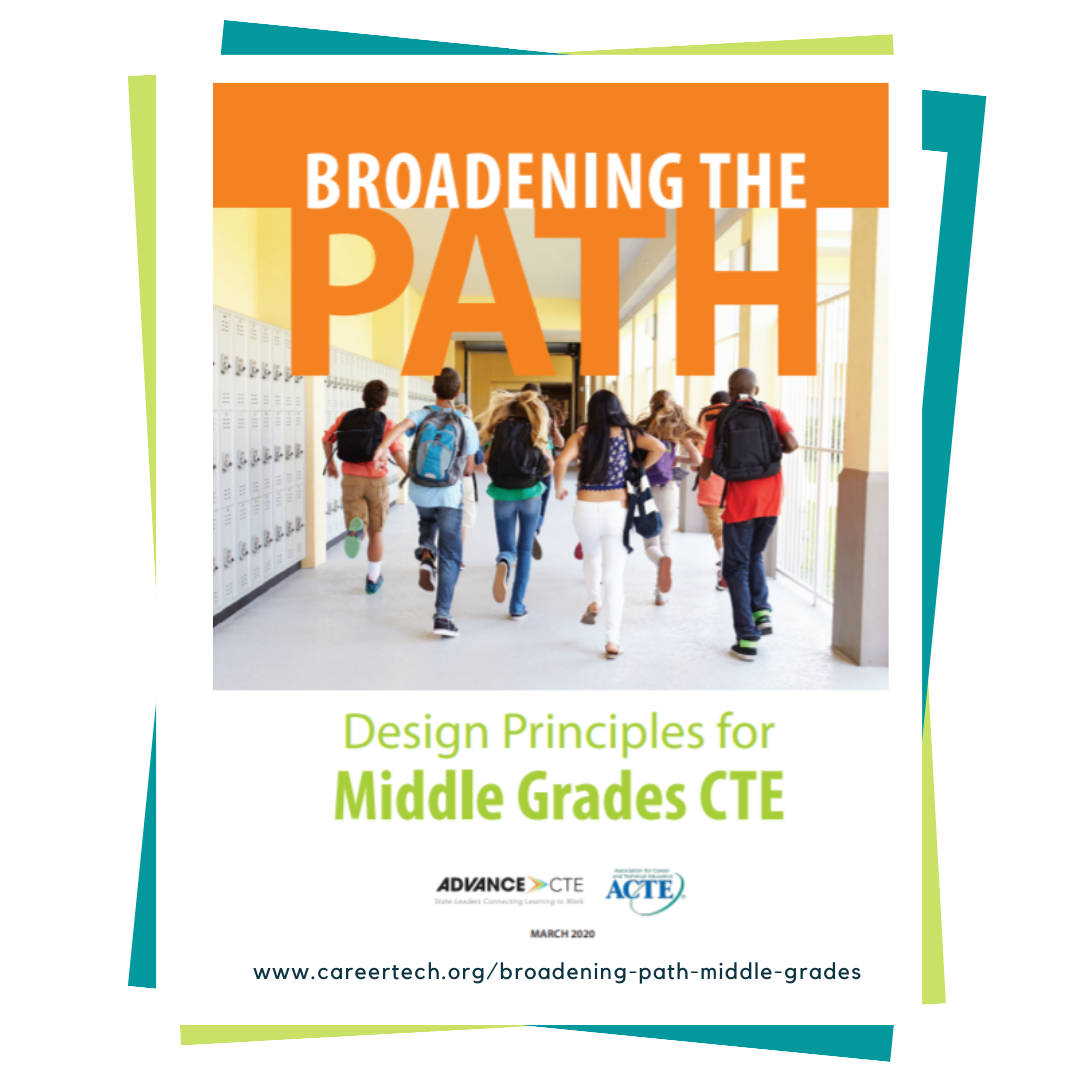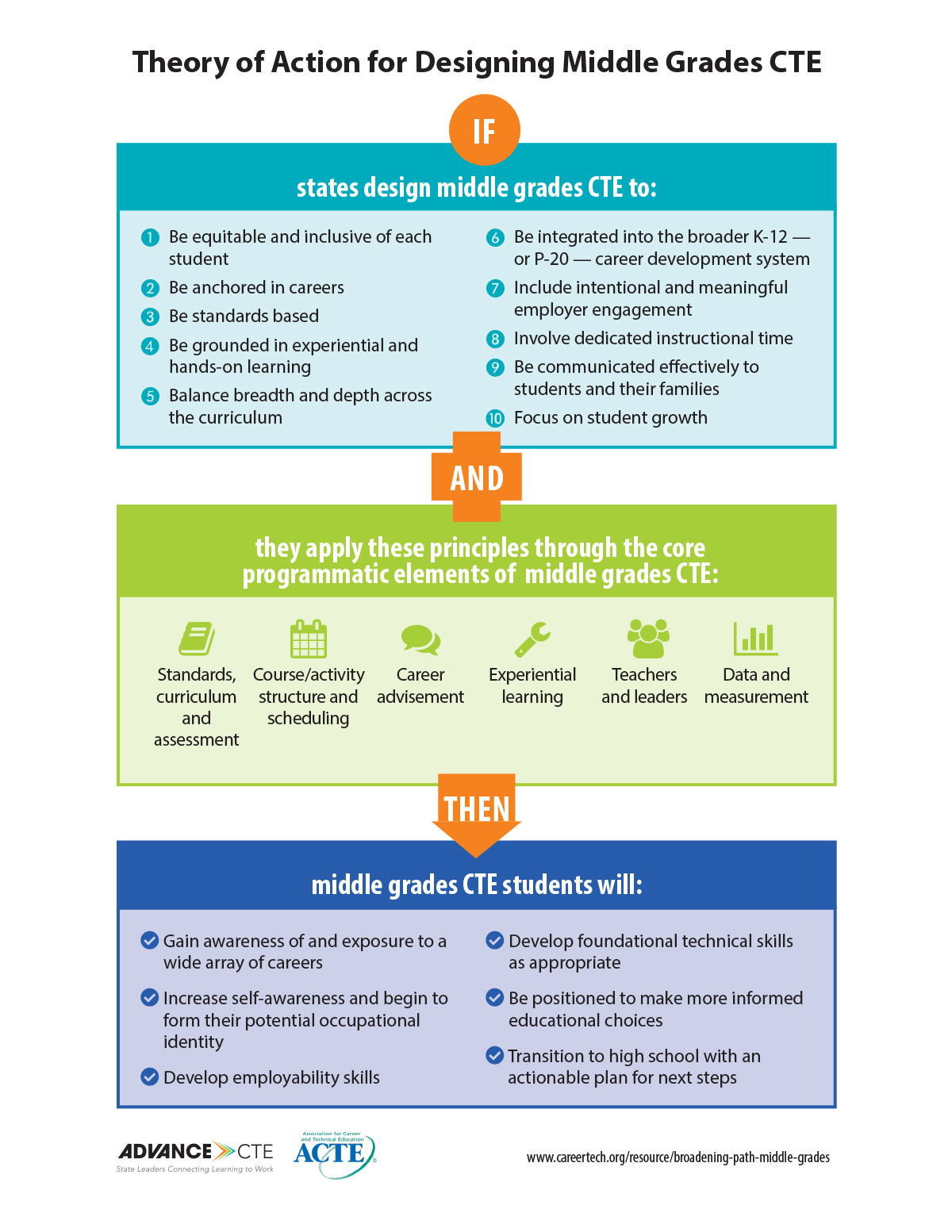![]() There is widespread agreement that high school is too late to begin to expose learners to careers and the foundational skills needed to access and succeed in careers, but there remains a lack of consensus about what Career Technical Education (CTE) and career readiness should entail at the middle grades level.
There is widespread agreement that high school is too late to begin to expose learners to careers and the foundational skills needed to access and succeed in careers, but there remains a lack of consensus about what Career Technical Education (CTE) and career readiness should entail at the middle grades level.
Advance CTE, with support from ACTE, convened a Shared Solutions Workgroup of national, state and local leaders to identify the core components of a meaningful middle grades CTE experience. This collaboration resulted in Broadening the Path: Design Principles for Middle Grades CTE and a companion blog series exploring each of the core programmatic elements of middle grades CTE defined in the paper. In this last entry in the blog series, we will examine effective middle grades CTE policy.
Policy actions often play a critical role in expanding access to high-quality middle grades CTE opportunities. Through effective policy actions, state CTE leaders can remove barriers that may prevent learners from accessing middle grades CTE opportunities, ensure there is adequate funding to support middle grades CTE, and create environments to incubate and scale middle grade CTE opportunities.
In 2014, H.B. 487 was enacted into law in Ohio, requiring schools to provide CTE courses in seventh and eighth grades by the 2015-16 school year. As a result, Ohio became one of the only states that requires the availability of CTE courses to middle school students at scale. Districts that do not want to offer middle school CTE must submit a public waiver to the Ohio Department of Education. Since the passage of the law, Ohio has seen a dramatic increase in access to CTE programs, with 21,551 students participating in middle grades CTE in 2015 and more than 73,728 students participating in middle grades CTE in 2017.
Similarly, In 2017, the Maine Legislature passed L.D. 1576, which updated the state’s definition of CTE to include language about middle school, effectively allowing middle school students in grades six through eight to participate in CTE. To expand access to middle grades CTE, the Maine Department of Education developed a Middle School CTE Pilot program, which allows institutions to apply for grants to pilot CTE opportunities that provide hands-on and interactive activities to middle grades students, as further described in an earlier entry in this blog series.
Numerous states plan to leverage the Strengthening Career and Technical Education for the 21st Century Act (Perkins V), which allows states to use Perkins funding to support CTE as early as the fifth grade, to expand access to CTE opportunities for middle grades students. For instance, Massachusetts is awarding Perkins V reserve funds to eligible agencies to better integrate career planning from the middle school through the high school levels. In its Perkins V state plan, Florida provides guidance to include aligned middle grades CTE programs within programs of study and allow middle grades students to take high school-level CTE courses early.
As state leaders reflect on effective middle grades CTE policy, they may consider the following questions:
- What policy actions could be leveraged to remove barriers preventing learners from participating in high-quality middle grades CTE opportunities?
- How does the state define CTE? Does the definition prohibit learners from participating in middle grades CTE?
- What changes to teacher licensing laws, if any, need to be made to mitigate middle grades CTE teacher shortages?
- What funding is needed to incubate and scale middle grades CTE opportunities? How can funds from Perkins V and other sources be braided to support middle grades CTE?
- How can policy actions be leveraged to align middle grade CTE programs to high school CTE programs?
- How can policy actions be leveraged to advance equity in middle grades CTE?
For additional resources relevant to CTE educators in the middle grades, check out the Middle Grades CTE Repository, another deliverable of this Shared Solutions Workgroup. To learn more about policy actions state leaders can take to advance middle grades CTE, read Expanding Middle School CTE to Promote Lifelong Learner Success.
Brianna McCain, Policy Associate



